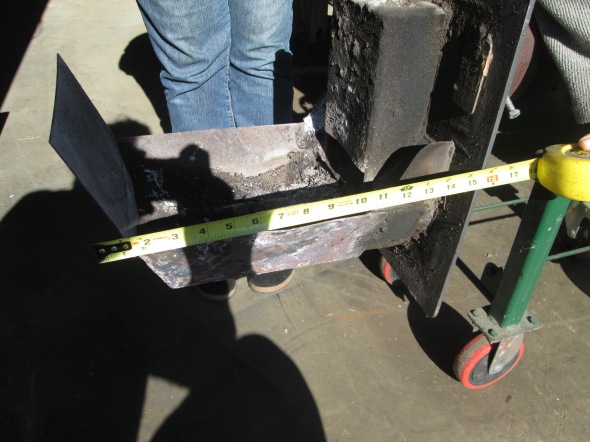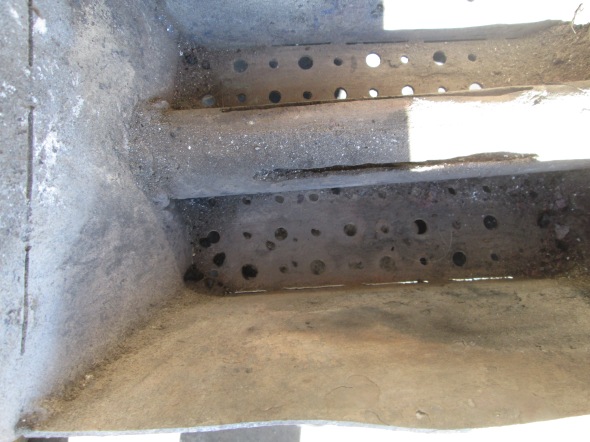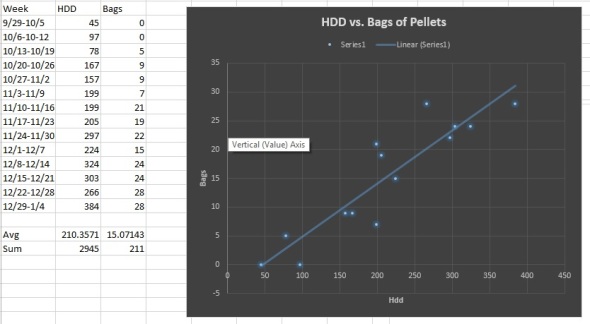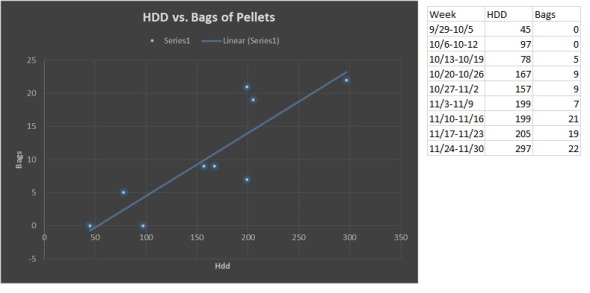Start of a new Burner Design
Posted: November 3, 2014 Filed under: Burner, Homemade Boiler | Tags: Arduino boiler control, boiler, Burn test, burner, homemade chip boiler 1 Comment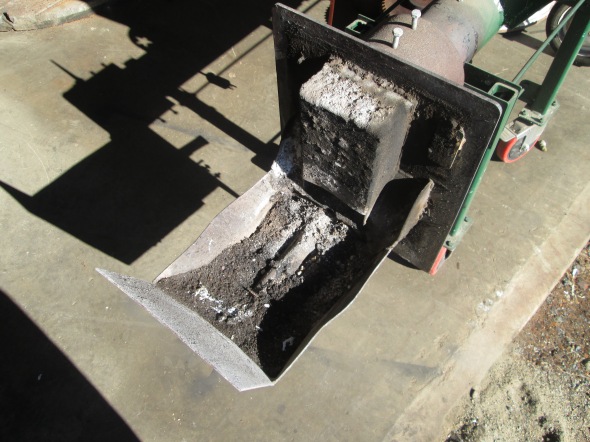 A friend with Solidworks has offered to draw up a new burner, so I thought I would post a few pictures of the old burner to help with dimensions. Here’s a picture of the uncleaned burner with about two inches of ash build up in the bottom of the burner.
A friend with Solidworks has offered to draw up a new burner, so I thought I would post a few pictures of the old burner to help with dimensions. Here’s a picture of the uncleaned burner with about two inches of ash build up in the bottom of the burner.
The tape measure in this view gives a little help with size. Originally the back flap was designed to help with air flow a sort of chimney effect, however this was of limited help and probably helped trap ash as do the high sides.
The larger holes are 1/2″ and the ash still doesn’t fall through unless stirred.
HDD vs. Pellets Update
Posted: January 14, 2014 Filed under: Arduino, Homemade Boiler, Testing | Tags: Arduino boiler control, homemade chip boiler Leave a commentIt’s been a cold ride here in New Hampshire for a few weeks. However, like a campfire, on average we may end up less than average on HDD’s for the month. I say like a campfire, because it always seems that one side is too hot and one too cold to really enjoy it, however on average….It’s raining hard here today, so once again the snow is leaving. This will ruin the skiing and winter sports and yet it’s really too cold to enjoy summer sports. Winter in Northern New England has become a lot like southern New England. But that’s a different topic.
The pellets seem to be a pretty steady 14HDD per bag. And so a ton this time of year lasts about two weeks, maybe a little longer. We bought our first ton this year, I was using up old stock and we bought a ton from Tractor Supply, their brand. I am liking them a lot, they seem to not cause any ash build up problems at all. I will buy them again. If you add up all the bags used and divide by 50 bags/ton we are at 4.22 tons heating season to date, for a total cost of $947.39 at the cost of $224.50/ton.
2013 in review
Posted: January 14, 2014 Filed under: Arduino | Tags: Arduino boiler control, homemade chip boiler, Software Leave a commentThe WordPress.com stats helper monkeys prepared a 2013 annual report for this blog.
Here’s an excerpt:
A New York City subway train holds 1,200 people. This blog was viewed about 7,200 times in 2013. If it were a NYC subway train, it would take about 6 trips to carry that many people.
Click here to see the complete report.
HDD’s vs. Pellets Part 3
Posted: December 17, 2013 Filed under: Homemade Boiler | Tags: Arduino boiler control, HDD, HDD vs. Pellets, Heating Degree Days, homemade chip boiler Leave a commentThe HDD’s reported from Weather Underground was 324 for the week of December 8-14 and I used 24 bags of fuel, more than would have been calculated by a simple ratio based on last weeks fuel usage, however very close to the trend line of the original scatter plot which I will post again here. So as time goes on the prediction gets a bit better. 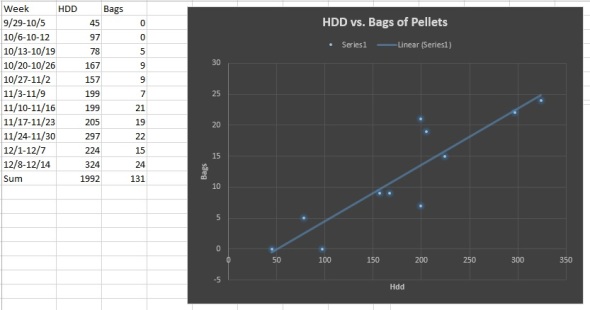
It’s shaping up to be about 13.5 HDD’s per bag of pellets, I have made minor changes to the software so, I think these numbers are getting more stable as time goes on. Note that December 2012 for the first two weeks added up to 431 HDD compared to December 2013’s first two weeks 548 HDD.
HDD Update for the first week of December
Posted: December 9, 2013 Filed under: Arduino | Tags: Arduino Leave a commentIn the first week of December I have used 15 bags of pellets to heat the house and shop including hot water. This weeks heating and hot water costs were $64.50. In the last post I calculated a monthly usage of 68 bags if this month followed the trend for December 2012 Heating Degree Days (HDD). So with 22.6% of the month gone I have used 22.0% of the fuel predicted. Probably not a good sign considering it will get colder as the month goes on (probably). In the first week the HDD were 224 in Springfield, VT. Last year the first week of December there were 211 HDD and not until the 3rd week was the weekly total as high as 224 barely topping this years first week at a whopping 226. So this may indicate a colder month than last year’s December.
No further progress on the boiler rebuild, I got distracted by obtaining a “free” hot tub. It had a fried control board, as well as a fried pump motor. I am sure the two are related and this should give me a clue as to how to fix the control board but, I have decided to replace the control board with a home built board consisting of relays. Several of these relays will be controlled by switches by the operator, and several will be controlled by an Arduino for example controlling the circulator pump and heater as well as reading the temperature sensors and reading the operators desire to raise or lower the temperature. That will probably keep me occupied in my spare time for a week or so. The second project in the shop is a sander which is giving me problems. I ended up buying a second sander to make sure I would be able to meet my contractual obligations but in the meantime, there is a sander taking up a lot of space while I wait for parts. It is a treat to work on it inside however, so I am not complaining just rationalizing why I am not working on the new boiler feed for chips.
HDD vs. Fuel Used
Posted: December 2, 2013 Filed under: Homemade Boiler, Testing | Tags: Cheap green heat, cheap heating, homemade chip boiler, pellets Leave a commentAbove is a scatter plot of Heating Degree Days (HDD) taken from Weather Underground data from the weather station in Springfield VT. Not exactly Newport, NH but close enough for this graph. It’s important to note that the beginning of October was quite nice which resulted in a fair number of days of timed burns, starting the boiler at 4 pm and running it until 9 pm for example. It quickly became obvious with Novembers below average weather that this would not result in satisfactory comfort and the boiler has been running continuously for most of the month. The trend-line looks like you would expect to see it, but the scatter data is quite varied. It will be interesting to see if this data correlates better as the winter continues.
The total pounds of fuel burned Heating season to date: 92 bags @40 pounds/bag= 3680 pounds vs. a total HDD to Date of 1444. Last year’s data for December indicates a HDD total for the month of 1069. This should result in 68 bags burned for the month for a total of 2720 pounds. Using $215 per ton this should be a monthly cost of $292.40 This is both heat and hot water. Be interesting to see at the end of the month how close the prediction comes.
You may remember I added a function to collect HDD data at one point, however it never seemed to work as well as it should have so I stopped using it, I am now considering reviving a variation of that function using an array for the max and min hourly numbers to get a more accurate HDD local number. I’ll post the code when I finish.
Timed run or continuous run now possible.
Posted: October 24, 2013 Filed under: Uncategorized Leave a comment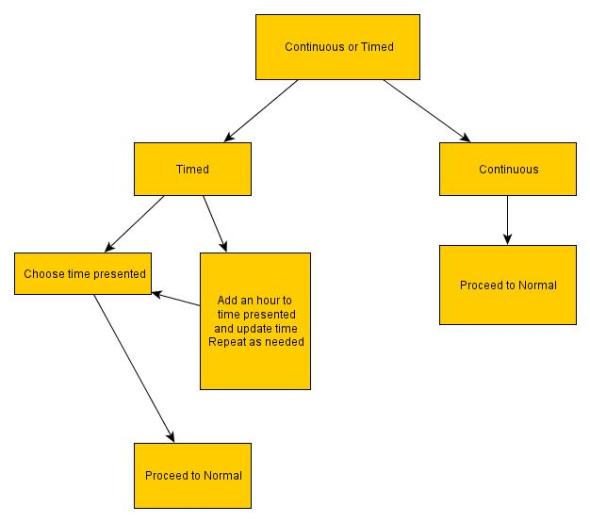 Last post discussed my software changes to shutdown the boiler in a controlled fashion, these changes included adding a button to choose the shutdown option. I now have added two more buttons. This allowed me to have more choice in the form of a menu system. As I am sure you all know an Arduino program, called a sketch consists of two main portions a start section and a loop section. The start section is only done once and the loop section as the name implies runs over and over again. In the start section I added a menu section that forces the user to choose first, continuous or timed.
Last post discussed my software changes to shutdown the boiler in a controlled fashion, these changes included adding a button to choose the shutdown option. I now have added two more buttons. This allowed me to have more choice in the form of a menu system. As I am sure you all know an Arduino program, called a sketch consists of two main portions a start section and a loop section. The start section is only done once and the loop section as the name implies runs over and over again. In the start section I added a menu section that forces the user to choose first, continuous or timed.
If you choose the continuous option you’re done choosing anything, except the ability to shutdown the program and the program resumes it’s normal function of running the pellet boiler. If you choose the timed option the software takes you to a second menu screen showing the current time, a choice to choose a proposed shutoff time 3 hours later and a choice to increase the proposed shut off time by an hour. Again if you choose the proposed shutoff time the program asks for a confirmation time and if you choose another hour that choice is now shown.
The system is simple to use at this point but needs error messages and further programming to make the software more robust. Tor example if you choose past 24 hours you either need to add a date component so that the program doesn’t just choose to shut off in an hour later or as I think if you are going to run it for more than 24 hours you should just choose continuous. I may change my mind on that but that’s my thinking at this point. Time, it’s all time.
On a side note in another iteration I will probably get smaller buttons and place them closer to the LCD, but for now this is the configuration. The buttons are pretty cool, I got them from http://www.sparkfun.com p/n COM-09336. There is a limit switch on the bottom which is really easy to solder to as well as being replaceable if needed. They have a nice positive feel. Again I might not buy this switch again because of it’s size but I do like it.
Minor Software changes can make life much more convienient
Posted: October 15, 2013 Filed under: Arduino, Homemade Boiler | Tags: Arduino, Arduino boiler control, homemade chip boiler, Software Leave a comment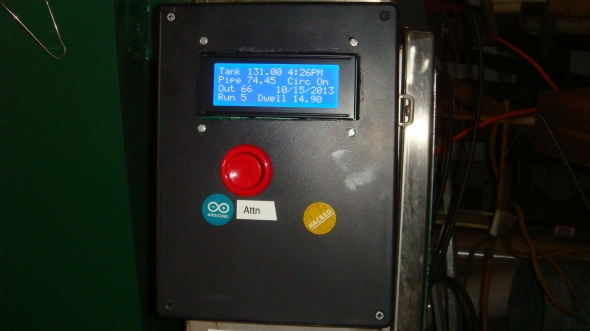 This time of year in New Hampshire it is warm days and cool nights. Pleasant for the most part but it is still fall. There can be some rainy raw days that need a touch of heat and to heat the hot water or maybe the day is warm enough but just cloudy so you want to heat the hot water for showers. So in other words the boiler can often run for 3-4 hours per night, maybe one or two evenings per week.
This time of year in New Hampshire it is warm days and cool nights. Pleasant for the most part but it is still fall. There can be some rainy raw days that need a touch of heat and to heat the hot water or maybe the day is warm enough but just cloudy so you want to heat the hot water for showers. So in other words the boiler can often run for 3-4 hours per night, maybe one or two evenings per week.
Shutting the unit down before the upgrade consisted of unplugging the unit which includes all the controls except the draft fan. This of course shuts off the feed and everything else but the fire still burns the remaining fuel. I keep the draft fan on to minimize any smoking that might occur otherwise. I live on the second floor of the building and the boiler is on the first floor so typically I would walk down unplug the unit, take a shower and then go back down and unplug the draft fan. More than once I have had to go down later after forgetting to unplug the draft fan. So I added a physical button, the Attn button, to the front of the control panel, and rewired the control box to relay control the draft fan. Now with a minor software change made I can go down hit the button and the unit shuts the auger feed immediately and then after twenty minutes turns off the relay for the draft fan. It’s so cool my girlfriend wants to go push the button. Can life get any better?
Summer’s almost over, time to start thinking about heat
Posted: August 21, 2013 Filed under: Arduino, Data logging, Homemade Boiler, Hopper and Feed, Plumbing the boiler, Testing | Tags: Arduino, CNC Plasma, homemade chip boiler, welding project Leave a commentI know it’s early on the calendar but my focus is starting to shift back to my heating hobby. After two years of experimenting I have a proven performer with both the mechanical unit and the software I used last winter. I could change nothing and go through the winter fairly smoothly but there is always room for more improvement. So this is my plan: 1) Build a new unit very similar to the proven unit I have been using but with greater feed range capability to allow the unit to feed wood chips as well as pellets. By building a complete new unit I can always roll up the proven unit after the experiment is over and the data collected and resume heating without a hiccup. 2) Make slight modifications to the boiler to allow a larger interface plate between the feed unit and the boiler. This will allow a greater range of experimentation with burner designs. 3) Continue making small experimental changes to the working pellet unit such as a vibrator for ash removal, different burner designs, different draft designs. 4) Continue to make changes and improvements to the software. To start I would like three modes of operation. Continuous, run for some amount of time, and run until a set time. I changed the software to run to a set time by calendar date last spring but it was built into the software by date not menu or button choice. I would like to have the option of running for a few hours for both experimentation and also to occasionally heat hot water and be able to choose these options by menu. This fall I am sure I would like the unit to be able to take the chill off and then shut down. 5) Build a chip dryer. This is going to get to be a priority , I know the days are getting a little shorter and it is amazing how much less solar there is in the fall. Time to giddy up on that one.
I know I have to prioritize the work, and work as time and cash flow allows. But I think the first step will be to make a new interface plate and boiler opening. This will allow standardization for the next design and this work can be done while there is no particular need for heat. I went dumpster diving the other day and got a great new electrical box, so I guess I can get going on the that part of the new burner feed. I like free stuff. I may hit that dumpster again soon.
In the mean time it is still summer and there is still sailing weather.
Fire!
Posted: April 23, 2013 Filed under: Arduino, Data logging, MicroSD card, Testing | Tags: Arduino, Arduino boiler control, Cheap green heat, chip boiler, DIY, homemade chip boiler Leave a commentWell of course there’s fire in the burner that’s how it works. After today however the Arduino should be able to sense the fire since I added a photo resistor, commonly known as a flame sensor, bought at a furnace supply store. With the Arduino’s ability to sense flame, the addition of automatic self starting should be enabled. The ability to determine if fuel is building up should also add safety to an already proven safe unit.
The sensor I obtained is a flame sensor used in a normal oil or gas fired burner. The flame sensor allows me to sense the light corresponding to a fire currently burning. The sensor cannot determine if the fire went out or if the flame sensor can no longer see it but functionally it makes no difference to me. I am interested in either condition and the response is the same to both conditions, turn off the fuel feed. If the fire went out, no need to keep feeding fuel, that will simply clog the feed chute and make a mess. If the fuel has backed up the feed chute so much as to shield the flame sensor, there is excess fuel, turn off the fuel feed. Physically the sensor is mounted to “look” through the back of the feed slide. This positions was chosen purposefully to determine if fuel was backing up.
Because the flame sensor is a resistor, I am using a voltage divider circuit to measure the voltage and then using the software to check the voltage with a if – then statement. The software determines if the voltage is high enough to indicate flame or too low indicating dark. I have been recording various sensor data to the micro SD over the heating season, so I will record the voltage overnight and we can see the range of data tomorrow. If anything this should be a good time of year for the test since the fire is needed to maintain the temperature in the building, it is mid 30’s F here today, but the fire is not required to be too vigorous since the temperature is not extremely cold.
Pictures and data to follow.

